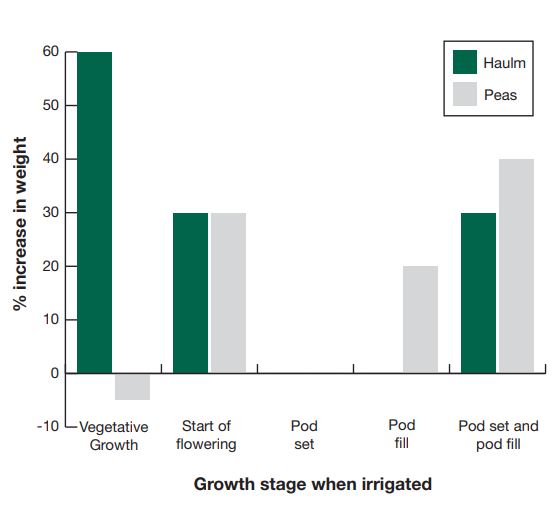Please click here to access the main AHDB website and other sectors.
- Home
- Knowledge library
- Irrigation in vining peas
Irrigation in vining peas
The timing of irrigation is important for all crops. These pages outline factors to consider, optimum timings, and potential drawbacks for vining pea crop irrigation.
This information was last updated in 2012.
Why irrigate vining peas?
While traditional farming systems in the UK focus irrigation on potatoes and high value vegetable crops, climate change and more unpredictable weather patterns means that irrigation of vining peas may be worth considering. The rooting depth of vining peas can be up to 80cm. The plants are influenced by soil structure and compaction and this fundamentally affects the plant’s access to any available water.
Plant stress
The effects of water stress can be minimised by ensuring peas are drilled into well-structured soils that encourage optimal root development.
Another consideration is the impact of irrigation on the development of diseases - it can both encourage disease and help in its management. For example, a wet environment can promote the development of Botrytis cinerea in vining peas but dry conditions encourage scab in potatoes.
A more vigorous, less stressed crop is generally able to defend itself against disease more effectively.
Vining peas: water stress and irrigation
Vining peas are very responsive to irrigation but timing is crucial and should be related to both specific crop growth stages and soil water deficit.
This chart outlines the impact of irrigation at the key stages of vining pea growth.
Figure 1. Response to irrigation in vining peas.
A restricted water supply reduces leaf size, stem extension and root development. It upsets plant water relations and reduces the efficiency of overall water use.
At a cellular and whole plant level there are various physiological and biochemical responses. Stomata close and carbon dioxide assimilation is reduced because of decreased enzyme function.
The associated production of reactive oxygen causes further damage to plant macromolecules and this is one of the major factors that reduces plant development.
Plants have mechanisms to cope with a degree of water stress and crop growth stage and duration of the dry spell are important factors. Equally, crop development stage is a critical factor determining the most effective time to irrigate.
Prolonged dry weather can ultimately cause excessive wilting and plant death.
The timing of irrigation in vining peas
Read about how to get the full benefit of irrigation by ensuring the best timing.
How much water do vining peas need?
Is there an optimal amount of water to irrigate vining pea crops with. The best increases in yield come when you allow well-timed moisture stress at key points in the crop’s development.
Original author
James Scrimshaw, PGRO
Topics:
Sectors:
Tags:


